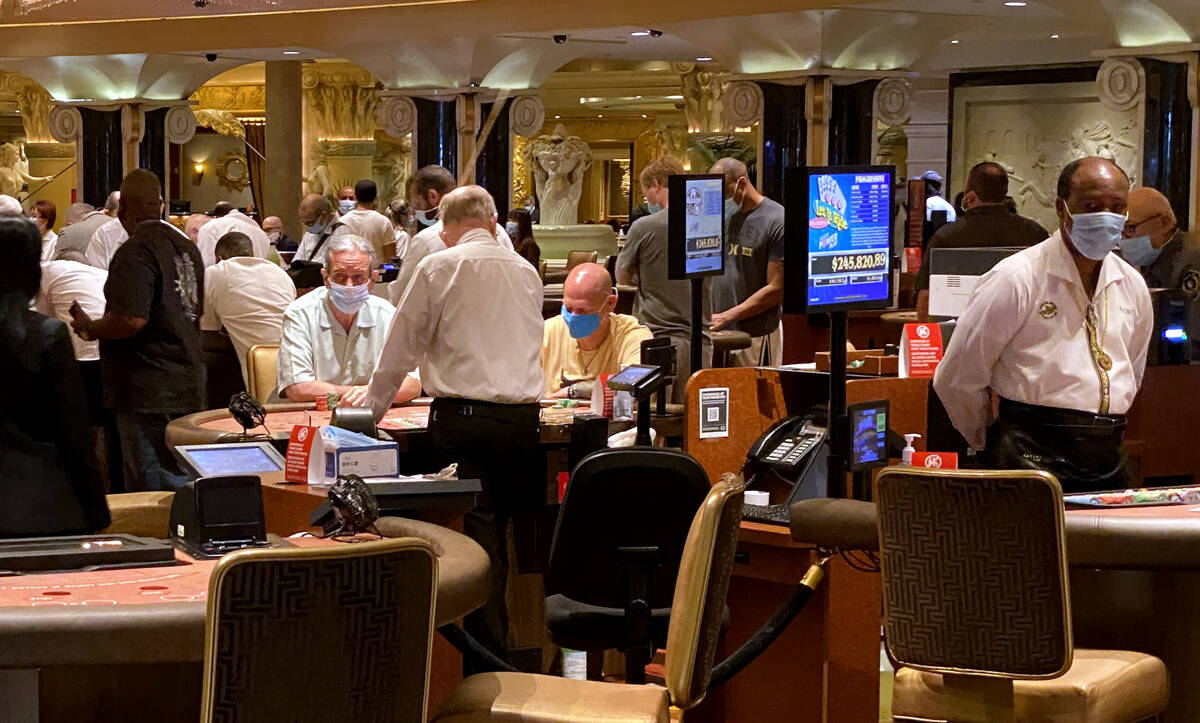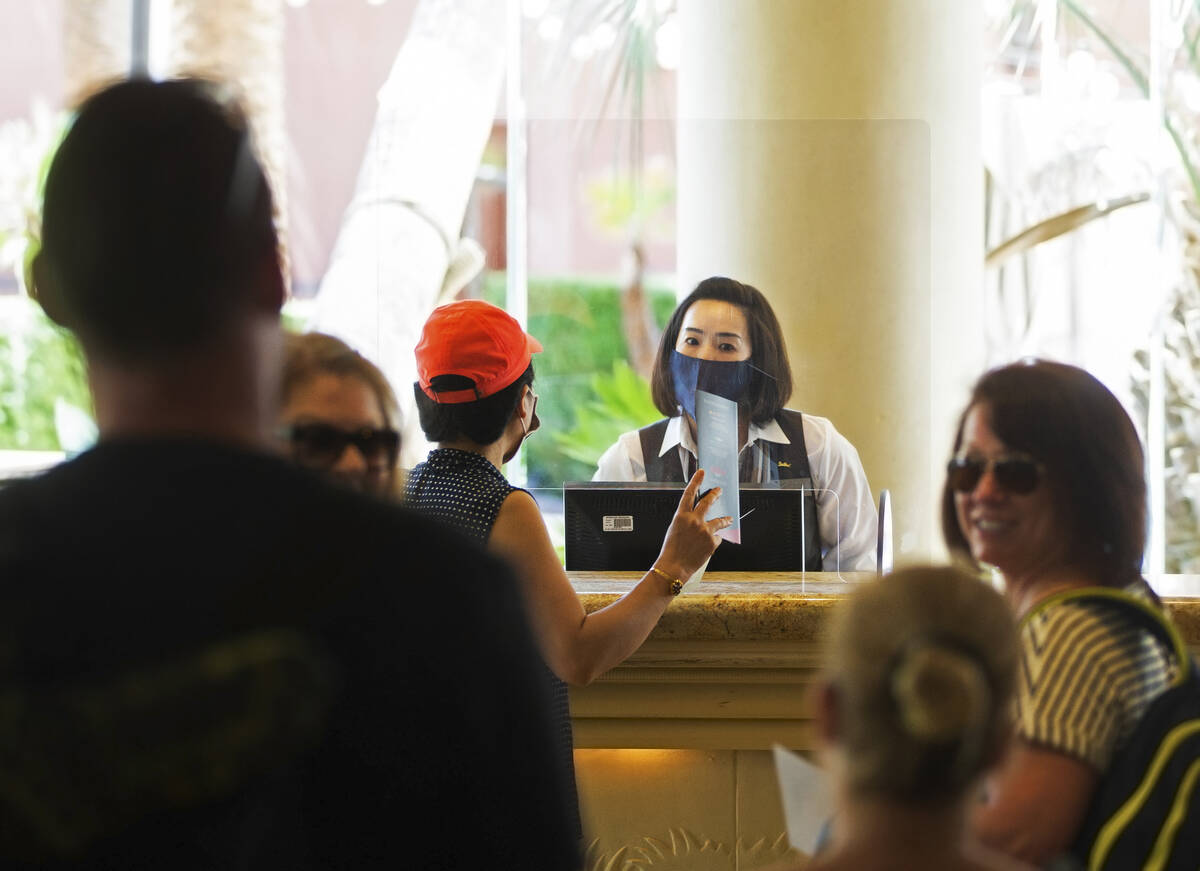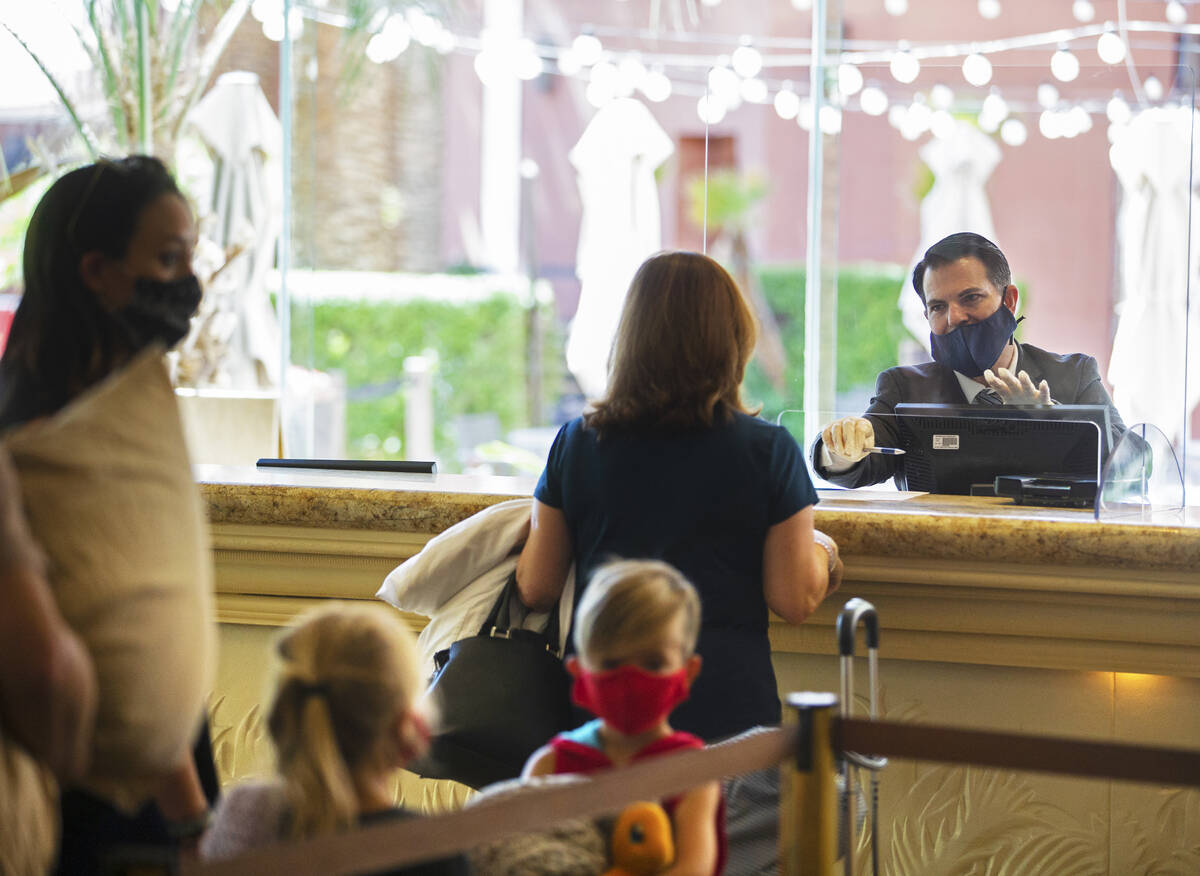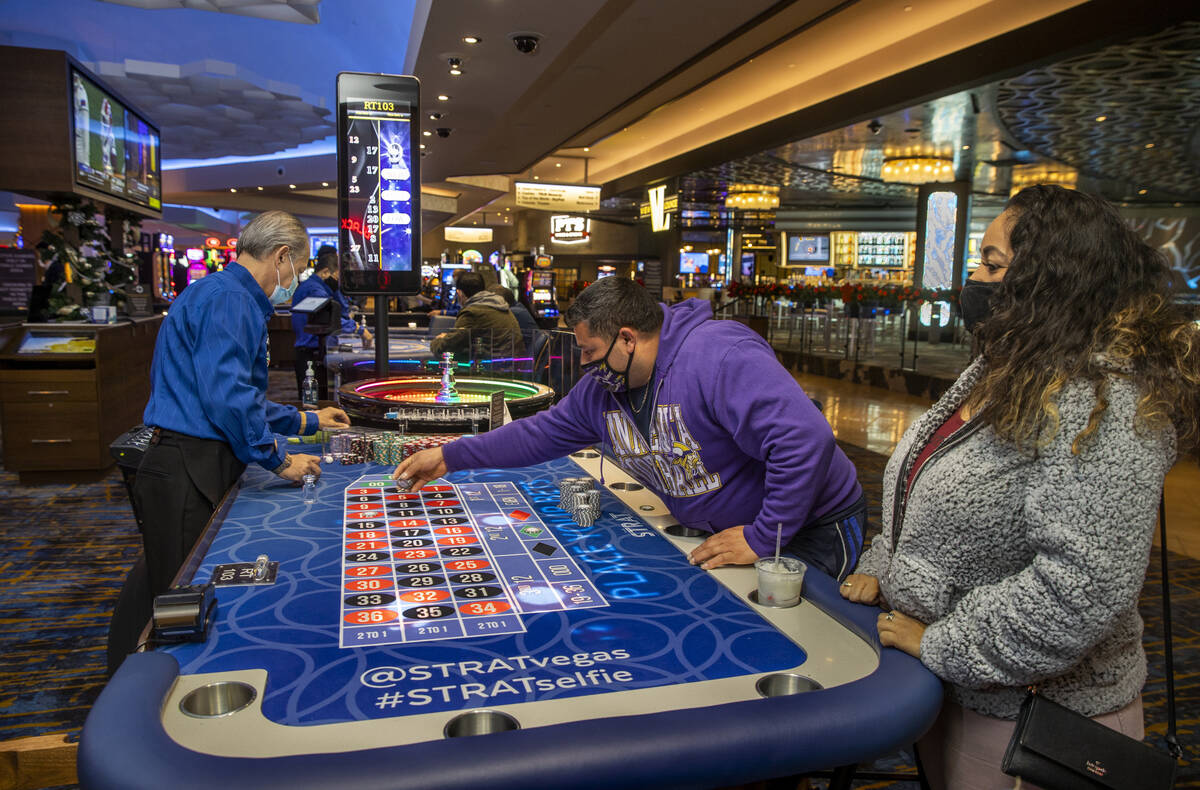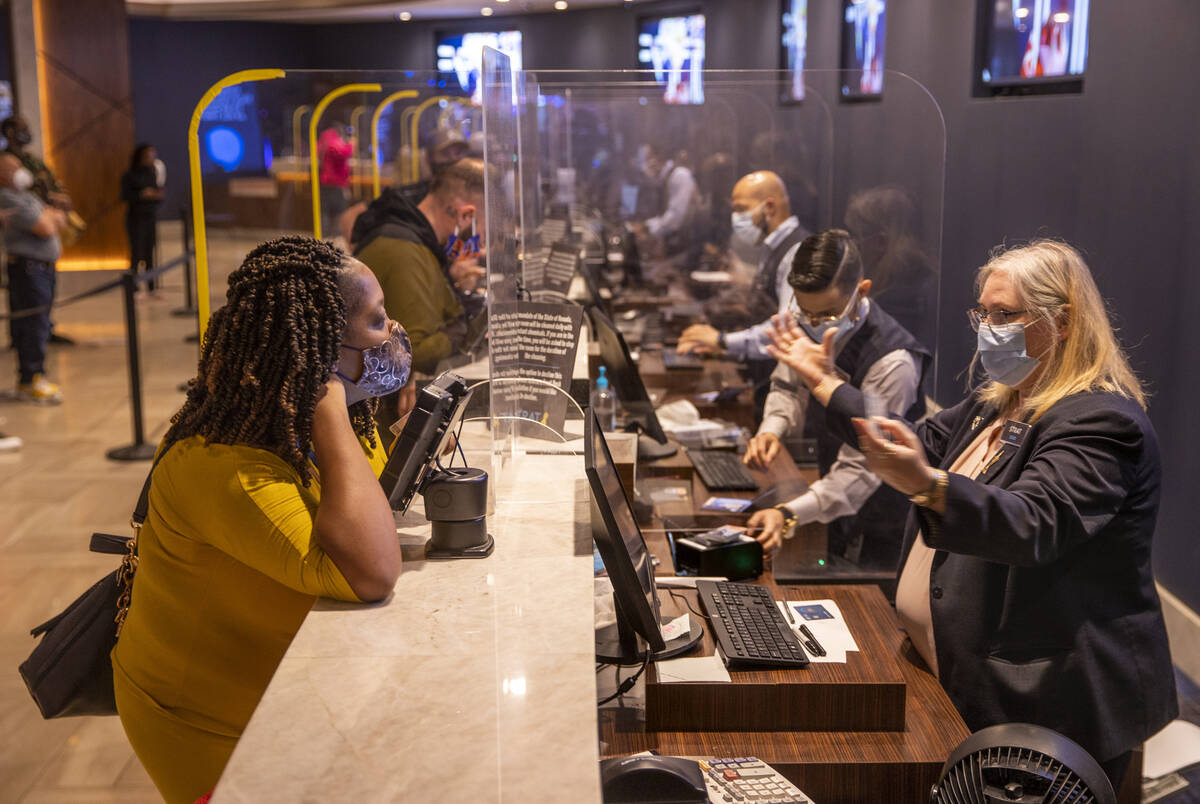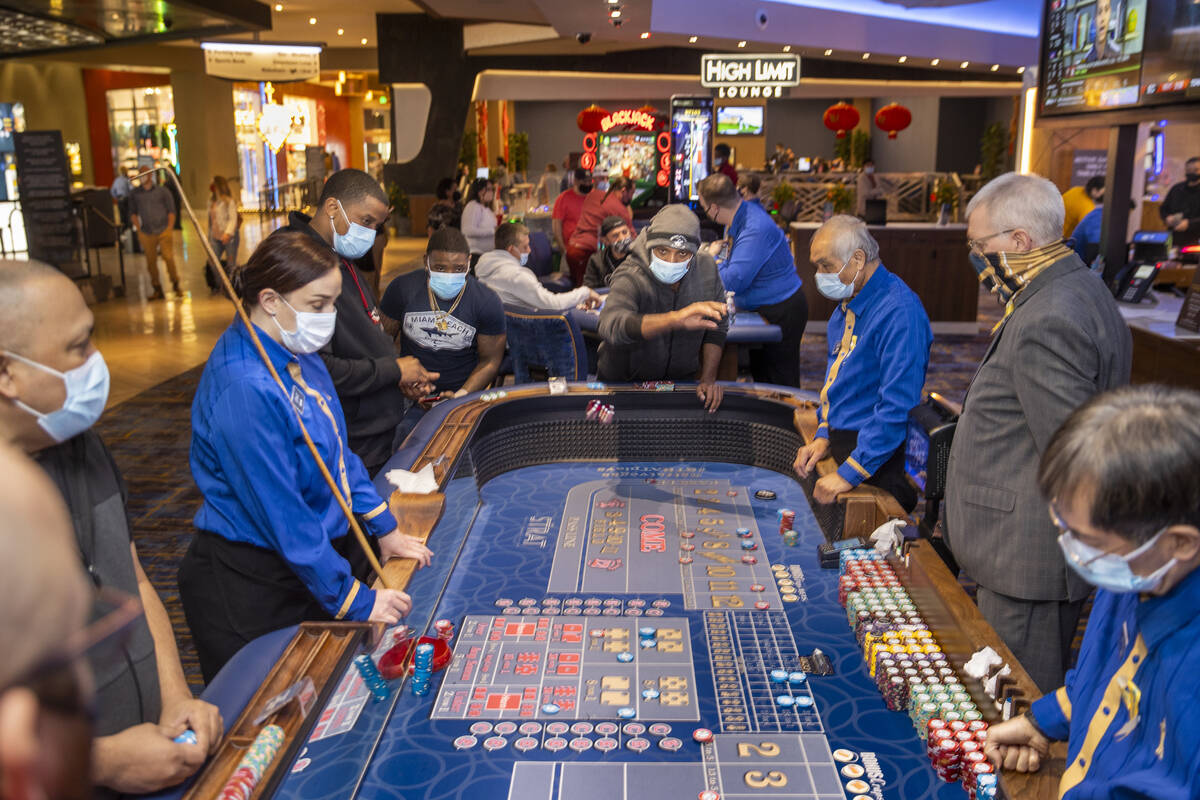Data offers glimpse of breakthrough risks for Southern Nevada workers
There have been more than 500 breakthrough infections of COVID-19 in fully vaccinated casino workers in Clark County, a number similar to that of health care workers, newly obtained data from the Southern Nevada Health District shows.
The data — collected by the health district during contact tracing investigations and not posted publicly — shows that, as of mid-October, there had been 562 breakthrough cases in people who identified themselves as casino workers and 575 in health care workers. Each group represents about 6 percent of total COVID-19 cases in fully vaccinated individuals.
Workers who identified as food handlers accounted for 416 cases, or around 4 percent of cases. By far the largest category in the data is “Other,” which includes 7,374 cases and does not break out job titles or industries. Without a clearer understanding of jobs within the “Other” field, the data’s full implications are unclear.
Still, the breakthrough data highlights the continued risks for casino, health care and food service workers, experts say, and it underscores the unique risks posed by unvaccinated tourists interacting with food-service workers and largely vaccinated casino workers.
The data was obtained through a series of public records requests by the Documenting COVID-19 project at the Brown Institute for Media Innovation and MuckRock as part of an ongoing collaboration with the Review-Journal.
Breakthrough case data sparse
While the data is far from complete, it shows how some public health data collected by local health departments is largely shielded from public view.
Unfortunately, detailed data on breakthrough cases is rare. In May, the Centers for Disease Control and Prevention stopped tracking and publishing breakthrough case information for all cases and now reports only those resulting in hospitalization or death. Because of the change, states aren’t required to monitor most breakthrough cases.
Epidemiologists say the Las Vegas breakthrough data, if collected and made public elsewhere, would be invaluable in continuing to fight the COVID-19 pandemic. More detailed data could point toward important trends in workplaces as many employers rush to ensure their employees are vaccinated, for example.
In September, breakthrough cases made up about 21 percent of reported new COVID-19 cases in Clark County, the district said on Sept. 30. That percentage has been steadily growing, In June the figure was nearly 12 percent of the month’s new cases, according to health district data. It wasn’t immediately clear how these percentages compared with current rates nationally; much of the readily available breakthrough data is calculated as a percentage of total cases since the beginning of the pandemic.
As of Sept. 30, the district said there had been 10,449 cumulative reported breakthrough cases in the county. This amounts to 3 percent of the 320,000 total reported COVID-19 cases. Breakthrough cases have been reported in less than 1 percent of the 1.2 million people who have been fully vaccinated.
Although the likelihood of becoming seriously ill with COVID-19 after being fully vaccinated is low, breakthrough case information on specific groups can show how different factors, such as the number of people working in a single space, result in infection.
The breakthrough data suggests employers and public health agencies should look closely at the environment of food handlers, such as whether they would be helped by better-fitting masks or a workspace with improved ventilation, said Julie Swann, head of the department of industrial and systems engineering at North Carolina State University.
The sheer numbers of people working in casinos and hospitality and their frequent interactions with customers mean breakthrough cases are more likely in these occupational groups, despite high vaccination rates, said Swann, who leads a team doing COVID-19 forecasting and intervention that is funded by the CDC and the Council of State and Territorial Epidemiologists.
Different risks for different jobs
According to the Bureau of Labor Statistics, there are about twice as many leisure and hospitality jobs in the Las Vegas area — 228,000 — as there are education and health services jobs, which number 104,600.
While the workplace setting of food handlers may be a cause of breakthrough cases, other jobs present different risks. Health care workers, for example, would be more likely to come in contact with people sickened with COVID-19. And health care workers, many of whom were vaccinated early on, are more likely to see their immunity waning.
“On the side of the casino workers, I suspect that they are around more unvaccinated people or more people that are not using masks perfectly than what you find in the health care setting. So their risk comes from a different type of bucket,” Swann said.
This is also true for food servers, who frequently interact with customers who go maskless as they eat and drink, she said.
“So effectively, inside a restaurant becomes much more like an unmasked environment for the waitstaff,” Swann said. “And, you know, we have no idea what the vaccination status of those people (customers) are.”
In most indoor venues in Clark County, people are not required to show their vaccination status but are currently required to wear masks.
“So, I would think that a bartending job, a waitstaff job, would be a pretty risky one,” Swann said. “I actually think that that could be riskier than a health care worker and casino (worker).”
According to the health district’s data, students accounted for 194 breakthrough cases, or 2 percent.
The single largest other category for occupation is “retired,” with 1,101 cases, or 11 percent.
‘Without context’
The Nevada Resort Association, which represents the state’s gaming industry, described the data as “incomplete, misleading and without context,” while noting that the breakthrough infections reported for casino workers represent a fraction of the industry’s vaccinated workforce.
“There is no indication of what period of time these numbers represent or whether these cases had underlying health conditions or other risk factors,” and no determination of where the workers might have been exposed, the association said in a statement. “Further, the workplace information is voluntarily self-reported and allows for a broad and subjective interpretation of the categories and multiple responses.”
The resort association also emphasized the lengths to which the industry has gone to protect its employees and customers.
“As a result of the on-site testing and vaccination clinics, paid time off, incentives and, in some cases, requirements for testing or vaccination, resorts have achieved much higher vaccination rates than the county’s eligible population with some resorts above 90 percent.”
For example, MGM Resorts International on Monday said that 84 percent of its workforce in Las Vegas was inoculated along with 98 percent of its salaried employees.
The Culinary union, which represents many front-line hotel-casino workers, also noted that a higher percentage of hospitality workers are vaccinated than in the public at large.
“We have been encouraging workers to be fully vaccinated, get their booster shots, wear a mask, and advocated in May 2020 for a mask requirement that includes customers,” Culinary Local 226 spokesperson Bethany Khan said in an email.
Data assembled after the fact
The health district declined a request for an interview on the occupational data, saying that staff was unavailable.
But in an email response to questions about the data, the health district said it did not gather occupational information to actively investigate breakthrough cases. Instead, researchers compiled the data after the fact from recent CDC case report forms. This means that the categories used as occupations are limited to the few fields on the form and are not the result of an extensive attempt to understand how breakthrough cases affect different workplaces.
The health district publishes more information about breakthrough cases than most states do, including race and ethnicity, gender and whether that person had an underlying health condition. Though all states are required to provide the CDC with information on breakthrough hospitalizations and deaths, only 35 states publicly report breakthrough data and just a handful report that data broken down by demographics, according to a report by Johns Hopkins last month.
More data, not less, is the first step in controlling the pandemic, and a more detailed understanding of how breakthrough cases affect essential workers and vulnerable populations is critical, said Dr. Julia Raifman, assistant professor of health law at Boston University and creator of the COVID-19 U.S. State Policy Database.
“We should have ongoing data on infections among essential workers and be studying how often essential workers need boosters and how to deliver boosters to them,” Raifman said.
Washington is among the few states currently tracking and providing detailed information on breakthrough cases. Its COVID reports now provide breakthrough case information by age, sex, and race and ethnicity, similar to how reporting is done by the Southern Nevada Health District.
In Washington, state health officials match COVID-19 test results with their immunization registry. While there are flaws and errors, the breakthrough data helps guide decision-making and monitor variants, said Washington State Epidemiologist Dr. Scott Lindquist. Washington also is one of the country’s leaders in genotyping, and Lindquist said that if officials saw a concerning uptick in breakthrough cases they could more easily pinpoint the emergence of a new variant.
‘We are leading the way’
The data also allows Washington officials to see how breakthrough cases are affecting people by age, race and ethnicity, Lindquist said.
“We value the data. It helps us determine direction,“ Lindquist said in an interview. “And we are leading the way with very active case finding for breakthrough cases.”
When asked about occupation level data, Lindquist described such information as a “luxury” that his state doesn’t have the capacity to track.
“It would really force that occupation or employer to go back and say, ‘How are you guys handling your vaccine?’ What if we found that the vaccine was inadequately stored?” Lindquist said.
But public health experts say more detailed data collection could forestall future health crises.
“How do we have systems in place to hit ‘go’ if there’s another wave?” Raifman said. “Delta brought us from record-low to record-high hospitalizations and deaths within weeks. So, we need our systems in place, ready to go when that happens.”
Contact Mary Hynes at mhynes@reviewjournal.com or 702-383-0336. Follow @MaryHynes1 on Twitter. Contact Dillon Bergin at dillon@muckrock.com or 267-314-7952. Follow @DillonBergin on Twitter.



